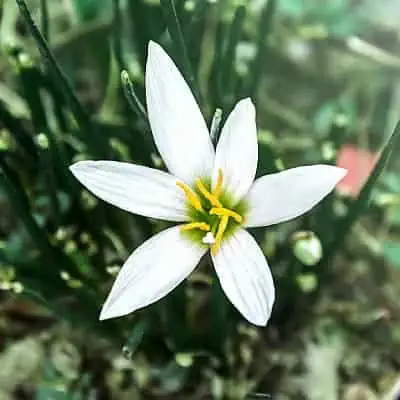When the temperatures start to drop and the days get shorter, you may be wondering what to do with your rain zephyr lilies. Do they need special care during the winter months? The good news is that these beautiful flowers are relatively easy to take care of, even when the weather outside is less than ideal.
How to grow and care Rain Lily||How to divide Rain Lily bulbs|| Zephyranthes Lily||BackyardGardening
- Bring your rain zephyr lilies indoors before the first frost
- Cut the foliage back to about 6 inches (15 cm) above the ground
- Water well and allow the soil to dry out completely between waterings
- Fertilize monthly with a balanced fertilizer such as 10-10-10
- Place the plants in a cool, dark location until new growth appears in springtime
Growing Rain Lilies in Pots
Rain lilies (genus Zephyranthes) are bulbs that thrive in warm weather and require little care. They are native to tropical and subtropical regions, but can be grown as annuals in cooler climates. Rain lilies bloom in late summer or early fall, after the rains have arrived.
The flowers last only a day or two, but the plant will produce many blooms over a period of several weeks.
Rain lilies grow best in full sun, but will tolerate partial shade. They prefer well-drained soil and should be watered deeply but infrequently, allowing the soil to dry out between waterings.
Fertilize rain lilies once a month with a balanced fertilizer during their growing season (spring and summer).
To pot rain lilies, choose a container that is slightly larger than the bulb itself. Fill the pot with well-drained potting mix and plant the bulbs so that they are just covered by the mix.
Water thoroughly and place the pot in a sunny location. Keep the soil moist but not soggy; too much water can cause bulb rot.
Once blooming has finished for the season, allow the foliage to die back naturally before removing it from the pot.
Store rain lily bulbs in a cool, dry place over winter and replant them in spring.
Rain Lily Blooming Season
It’s that time of year again! The rain lilies are blooming and the sight is simply breathtaking. These beautiful flowers only bloom after a rainfall, hence their name.
They are native to tropical and subtropical regions and typically bloom from late spring to early fall.
If you’re lucky enough to have rain lilies in your garden, now is the time to enjoy them. But even if you don’t, take a stroll through your local park or nature reserve and see if you can spot any in bloom.
Trust us, it’s well worth the effort!
How to Prune Rain Lily
Pruning rain lily is a simple process that can be done with little effort. The main thing to remember when pruning rain lily is to remove the spent flowers and seed pods. This will encourage the plant to produce new flowers and help keep it looking its best.
To prune rain lily, start by cutting off any spent flowers or seed pods. Then, trim back any leaves that are yellow or brown. Once you have removed all of the dead growth, you can shape the plant as desired.
When shaping rain lily, it is important to leave at least 3-4 inches of stem above the ground. This will ensure that the plant has enough energy to produce new growth.
Once you have finished pruning rain lily, water it well and fertilize it if needed.
With proper care, your rain lily should bloom abundantly throughout the season!
Rain Lily Sunlight Requirements
The rain lily is a beautiful and unique flower that is native to South America. It gets its name from the fact that it blooms after a rainfall. The rain lily is also known as the zephyr lily, spider lily, or resurrection lily.
It belongs to the amaryllis family and is closely related to the Belladonna Lily.
The rain lily is a bulbous plant with long, strap-like leaves. The flowers are white, pink, or purple and have six petals.
They are borne on slender stems and bloom in late summer or early fall. The flowers only last for a few days before they wither away. However, each plant can produce several flowers over the course of a season.
Rain lilies are relatively easy to grow and care for. They prefer full sun but will tolerate partial shade. They need well-drained soil and should be watered regularly during the growing season (spring and summer).
However, they do not like wet feet so make sure the soil does not stay soggy for extended periods of time. Bulbs should be planted in the fall at a depth of 4-6 inches (10-15 cm).
If you live in an area where it rains frequently, then you may never have to water your rain lilies!
However, if you live in an area with little rainfall, then you will need to water them more often (about once per week). When watering, make sure to soak the ground thoroughly so that water reaches down to the bulbs.
Rain Lily Not Flowering
If your rain lily isn’t flowering, there are a few things you can check to try to troubleshoot the issue. First, make sure that it’s getting enough sun. Rain lilies like to be in bright, direct sunlight for at least six hours a day.
If it’s not getting enough sun, try moving it to a brighter spot. Second, check the soil moisture. Rain lilies like their soil to be moist but not soggy.
If the soil is too dry, water it well and see if that helps. Third, check the temperature. Rain lilies prefer warm temperatures and will go dormant if the temperature drops below 50 degrees Fahrenheit.
If it’s too cold where you live for rain lilies to grow outdoors, you can try growing them indoors in a pot near a sunny window. Finally, make sure your rain lily is getting enough fertilizer. Use a balanced fertilizer once every two weeks during the growing season (spring and summer).
If you follow these tips and your rain lily still isn’t flowering, it may just be that it needs more time to mature before it blooms.

Credit: pondinformer.com
Do Lilies Need to Be Cut Back for Winter?
No, lilies do not need to be cut back for winter. They are a hardy plant and will survive the cold weather just fine. However, if you live in an area with very harsh winters, you may want to consider covering your lilies with a burlap cloth or something similar to protect them from the elements.
Do You Cut Back Rain Lilies?
No, you do not cut back rain lilies. These plants are known for their beauty and resilience, and they require very little maintenance. Rain lilies will bloom reliably every year without being trimmed or deadheaded.
In fact, cutting back the foliage of a rain lily can damage the plant and prevent it from blooming. If you want to tidy up your rain lily bed, simply remove any dead leaves or stems. Otherwise, leave these tough little plants alone and enjoy their colorful flowers!
What to Do With Lilies in Pots Over Winter?
When it comes to lilies in pots, there are a few things you need to do in order to ensure they make it through the winter. First, you will want to make sure that the pot is big enough. Lilies have large bulbs and roots, so they need a lot of space.
If the pot is too small, the roots will be constricted and the plant will not be able to survive the winter.
Next, you need to make sure that the pot has drainage holes. Lilies like their soil to be moist but not soggy, so having good drainage is essential.
If your pot does not have drainage holes, you can drill some yourself or simply choose a different pot.
Finally, you need to protect your lily from frost damage. This can be done by placing the pot on a tray of pebbles and water or by covering it with straw or bubble wrap.
Whatever method you choose, just make sure that your lily is protected from any cold weather.
With these tips in mind, you should have no problem keeping your lily alive and thriving all winter long!
Do Rain Lilies Come Back Every Year?
One of the most common questions about rain lilies is whether or not they come back every year. The answer is yes, rain lilies do come back every year, provided that they are cared for properly.
To ensure that your rain lily will bloom again next year, start by planting it in a location that receives full sun to partial shade and has well-drained soil.
Once it is planted, water it regularly and fertilize it monthly during the growing season.
In the fall, stop watering and fertilizing the rain lily as it prepares to go dormant for the winter months. Once spring arrives, resume watering and fertilizing to encourage new growth.
With proper care, you can enjoy beautiful blooms from your rain lily year after year.
Can I Use the Same Care Tips for Rain Zephr Lillies for My Bouquet of Tulips in the Winter?
Can I use the same care tips for Rain Zephyr Lilies for my bouquet of tulips in the winter? When caring for tulip bouquets during winter, it is important to keep them in a cool location away from direct sunlight and heating sources. Change the water every couple of days, trim the stems at an angle, and remove any wilting or dead petals. Additionally, adding flower food to the water can help prolong their freshness.
Conclusion
This blog post covers how to care for rain lilies, also known as Zephyr lilies, during the winter months. The author recommends storing the bulbs in a cool, dry place over winter and replanting them in spring. They also suggest fertilizing the bulbs before storage and every few weeks during the growing season.






